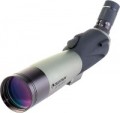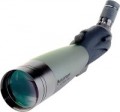Magnification
The magnification of the image provided by a telescope. Roughly speaking, this parameter describes how many times the object seen in the eyepiece of the pipe will be larger than when viewed from the same distance with the naked eye.
Multiplicity — the first number (numbers) in the digital marking of optical instruments: for example, the designation 25-75x50 corresponds to a multiplicity from 25x to 75x. Note that most modern telescopes have variable (adjustable) magnification. This allows you to choose the mode of operation depending on the situation: to search for the desired object, it is more convenient to reduce the magnification, providing a wide field of view, and having found it, increase the magnification and examine in detail. However in some models, to change the magnification, you need to replace the eyepiece (see "Replacement eyepiece").
High magnification, on the one hand, makes the tube "long-range" and makes it easy to examine small objects at considerable distances. On the other hand, the angle of view decreases in this case, which makes it difficult to observe moving objects and even aim the optics at the target. In addition, with an increase in the magnification, the diameter of the exit pupil also decreases (see below) and the aperture ratio of the tube; you can compensate for this moment by increasing the lens, but this accordingly affects the price. So it makes sense to specifically look for powerful optics with a high degree of ma...gnification only when such capabilities are fundamentally important.
Field of view 1 km away
The field of view of the telescope at a distance of 1 km to the objects under consideration, the so-called "linear field of view". In fact, this is the width (diameter) of the space that falls into the field of view when observed from a distance of 1 km.
This parameter is widely used in the characteristics of telescopes along with the angular field of view (see below): the linear field of view data is more visual and closer to practice, it allows you to evaluate the capabilities of a telescope without resorting to special calculations.
For models of variable magnification (the majority of them), the linear field of view is indicated in the form of two numbers — for the minimum and for the maximum magnification.
Angle of view
Angle of view provided by a telescope.
If you draw two lines from the centre of the lens to two opposite points along the edges of the field of view of the pipe, the angle between these lines will correspond to the angular field of view. Accordingly, the larger the angle, the wider the field of view; however, individual items in it will look smaller. Conversely, an increase in magnification is inevitably associated with a decrease in the viewing angle. And since most modern telescopes have a variable magnification, the angular field of view is also variable, and in the characteristics this indicator is indicated in the form of two numbers — for the minimum and for the maximum magnification.
Min. focus distance
The smallest distance to the object under consideration at which the telescope is able to fully focus on it — that is, the minimum distance at which the image in the eyepiece will remain clear.
Spotting scopes were originally designed for viewing distant objects, so focus problems can occur if the distance is too small. Thus, manufacturers indicate this parameter in the characteristics. However, even in the most powerful and "long-range" models, the minimum focus distance is about 25 m — at this distance, the naked eye is often enough. Therefore, you should pay attention to this parameter only in cases where the ability to work normally close is of fundamental importance — for example, if the pipe is used at a shooting range, where the distance to the targets can be different, including pretty small.
Lens diameter
The diameter of the objective is the front lens of the telescope. The term "aperture" is also used for this characteristic.
The lens diameter is one of the most important characteristics of an optical system: the amount of light entering the lens and, accordingly, the image quality (especially in low light) directly depend on the aperture. From the point of view of optical characteristics, we can definitely say that the
larger the lens, the better, especially at high magnification (for more details, see “Exit Pupil Diameter”). On the other hand, large lenses significantly affect the size, weight, and most importantly, the cost of telescopes. Therefore, manufacturers usually choose the lens size taking into account the magnification, price category and the specifics of the use of a telescope — especially since at low magnifications and good lighting, even a relatively small aperture may well provide a high-quality image. For more information about these patterns, see "Exit Pupil Diameter". In addition, it is worth noting that the features of the "picture" are affected not only by the mathematical characteristics of the optics, but also by the overall quality of its components.
Exit pupil diameter
Exit pupil diameter of a spyglass.
The exit pupil is the projection of the image "seen" by the tube that appears just behind the eyepiece. A person sees an image in a telescope precisely due to the fact that the exit pupil is projected onto the eye.
The exit pupil diameter corresponds to the size of the lens divided by the magnification (see above for both). For example, for a pipe with an aperture of 50 mm, operating at a magnification of 25x, this size will be 50/25 = 2 mm. At the same time, it is believed that in order to ensure the most bright and comfortable image, the exit pupil should be no smaller than the pupil of the observer's eye — and this is 2-3 mm in the light and up to 8 mm (in the elderly — up to 5-6 mm) at dusk. This is the reason why for comfortable work at high magnifications and/or in low light conditions, a telescope must have a fairly large lens. However, most of these optical devices are designed for daytime use, and for this, an exit pupil of 1.33 mm in size is sufficient.
For most modern telescopes, the exit pupil diameter is indicated by two numbers — for the minimum and for the maximum magnification.

